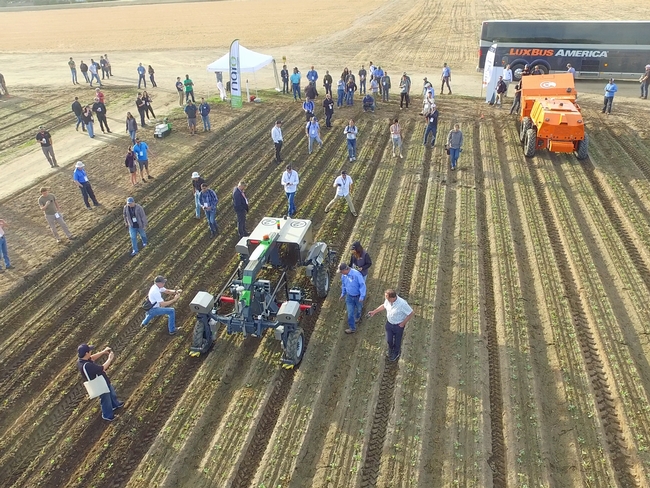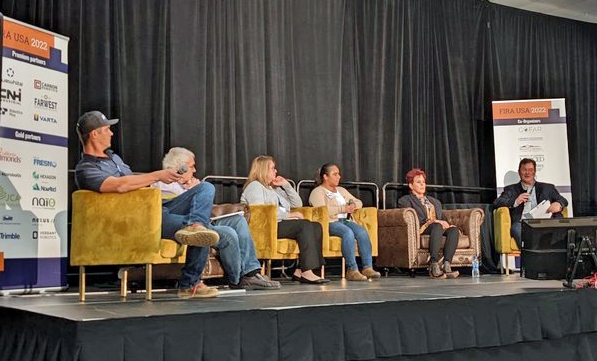First FIRA USA Ag Robotics Forum attracts people from around the world
Agriculture and the global food supply is threatened by a range of issues including drought, climate impacts, increasing business costs and labor scarcity. To forge solutions to these issues and more, nearly 1,000 attendees from 26 countries converged in Fresno on Oct. 18-22 for the inaugural FIRA - World Ag Robotics Forum to be held in the U.S. The event was co-sponsored by UC Agriculture and Natural Resources' The Verde Innovation Network for Entrepreneurship, or the VINE.
Widely observed as a pivotal moment for agricultural technology and robotics in U.S. agriculture, the event was kicked off by California Department of Food and Agriculture Secretary Karen Ross and moved into a packed agenda with panel discussions, lightning talks and pitches where automation company representatives, academics and growers had the opportunity to share their challenges, concerns and hopes for the future of autonomous farming. The event culminated at CSU Fresno with more than a dozen companies offering in-the-field demonstrations.
Although growers are the target market for most of the equipment, the benefits of automation can ripple out into society, according to Glenda Humiston, University of California vice president for agriculture and natural resources.
“Technology can help us grow, harvest and distribute food more efficiently so that it can become more affordable and accessible for those who are food insecure,” said Humiston. “If we do this right, it's good for the whole community.
Here are a few themes and takeaways from this pioneering multi-day event.
Gaining on-farm use - Focus on end-user needs and ease of use
A major question speakers tackled was why more growers aren't yet integrating automation on their farms. Automation solutions exist and are being developed to help growers in nearly every aspect of running a farm — from planting, harvesting and weeding to addressing persistent labor shortages. Despite this, ag automation companies – both big and small – still face resistance from growers to adopting new technologies.
Part of the problem, Jeff Morrison of Grimmway Farms said during a panel on mechanization versus automation, is that companies pay more attention to their product than the needs of the grower. “Farmers want technology that fills a particular need,” he said. Anna Haldewang, the founder of InsightTRAC, agreed. “Don't be married to your product, be married to your customer.”
Chuck Baresich, president of the Haggerty AgRobotics Company, emphasized the importance of creating automation solutions that are simple and intuitive to use. “For a manufacturer, the first thing I'd tell them is don't overcomplicate things,” he said. “Make sure your robot can drive straight, start with that.”
Panels also touched on the technical, business and regulatory challenges to automating agriculture. The ag tech startup market is much younger than Silicon Valley, and we don't yet know the best route to establishing a successful business, Rob Trice of Better Food Ventures and The Mixing Bowl observed during a panel on robotic product development with key industry leaders, including Walt Duflock, vice president of innovation for Western Growers. That said, panelists identified three things that startups should do:
- Get prototypes into the field as quickly as possible to get performance data and get feedback, including from farmworkers, who may come up with multiple uses for the product.
- Be transparent about development to build partnerships with investors and growers. Partners understand that startups are a work-in-progress.
- Be ready to evolve and change your technology or your business to meet the customers' needs. Love the customer, not the tech.
AgTech, Labor and Farmworkers - Forging win-win opportunities
Labor issues also emerged as a persistent theme during the event. One of the major forces driving the need for automation in agriculture is persistent labor shortages. Simply put, farmers do not have sufficient labor to sustain their operations and are turning to agtech, robotics and automation to fill the gap. At the same time, as robotics and automation take hold in the agriculture industry, farmworkers and farm labor organizations are rightly concerned about the impact that the adoption of automation will have on agriculture jobs, in particular farm labor jobs.
Hernan Hernandez of the California Farmworker Foundation acknowledges the labor concern, but also sees opportunity. “All of a sudden, you go from 100 individuals that are going to be able to harvest this season to now 10 that will harvest with a machine," he said. "But the way we look at it is as well, when we talk to farmworkers and engage them, and we look at data, there is also opportunity. We know a lot of the farmworkers want opportunities to further their skill sets.”
We've got to find ways to help our farm workers actually get the training they need to make use of this technology, which will give them a better quality of life.
This sense of optimism about the future of the farmworker was shared by Gabe Youtsey, chief innovation officer of UC ANR, who moderated a panel on the future of agricultural work. “California as a whole has begun recognizing the importance of creating the next generation of ag workers,” he observed, “and schools and industry have both taken notice.” Indeed, California community colleges have begun working on new relevant programs that translate directly to jobs, and the federal government has allocated $10 million going directly to Central Valley agricultural education and workforce development programs.
What's next?
The gathering also served as a platform for launching new technology initiatives. Youtsey, in collaboration with our partners at UC Davis AI Institute for Food Systems, announced the 2023 Farm Robotics Challenge at FIRA USA 22! We look forward to co-hosting this event!
It is clear that automation and robotics will play an increasingly crucial role in agriculture. Not only in addressing the pronounced labor shortage in agriculture, but by creating new value creation opportunities related to resource efficiency, crop health, disease, harvesting and more.
“Our job at The VINE is to drive collaboration between industry, academia and government forward,” said Youtsey. “Robotics is moving very fast and there's a new set of players coming into the space. UC Cooperative Extension advisors can bring startups and farmers together in creative new ways during development and advance these solutions into commercialization faster.”
Co-sponsors of the conference included FIRA, Western Growers, University of California, Merced, California State University, Fresno and the Fresno-Merced Future of Food (F3) Innovation Initiative.
Industry sponsors included Bluewhite, Carbon Robotics, CNH Industrial, Far West Equipment Dealers Association, Grimmway Farms, Keithly-Williams Seeds Inc., Robotics Plus, VARTA AG, and Sonsray Machinery, LLC.
For more information
- Subscribe to the FIRA Newsletter HERE and check the website for future events.
- Interested in the 2023 Farm Robotics Challenge?Learn more at https://farmbot.ai.



